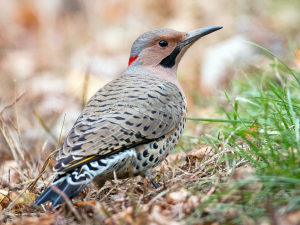Support Us
Since 1979 more than 140,000 animals have been treated by Wildlife Rescue.
Thanks to the support of individuals like you, Wildlife Rescue can provide a lifeline for animals in distress.
Every year, World Environment Day is a reminder that we must protect and conserve our environment. This year’s theme, biodiversity, is a pressing issue. By continually pushing nature’s delicate systems to the limit, our environment is thrown off its balance affecting all species. Over 190 species of birds have gone extinct, and that number is only increasing. Focusing on ways we can contribute to a healthy ecosystem is crucial to protecting the species we have left.

Birds like Northern Flickers, brown woodpeckers with black dots on their bellies and black tails, are slowly declining in numbers throughout North America. Flickers have a healthy population in British Columbia and can be identified by their sharp call, red underwing, grey head, and brown crown. The males have red moustache stripes while the females have brown moustaches. Some male red-shafted birds also have red nape crescents.
Recently, three orphaned nestlings were taken into Wildlife Rescue’s care. Young are fed through regurgitation by their parents until they can accompany adults to learn how to forage. Northern Flickers find their food from the ground by scavenging for insects (ex. ants and beetles), fruits, and berries, hopping from place to place as they learn how to fly.
Found across British Columbia, these adaptable creatures can live in many different ecosystems and elevations, including suburban areas and grasslands. During breeding season from March to June, they are found in the forest where male and female Northern Flickers will work together to build nests. The two parents have up to 9 eggs together, which they incubate for up to 11 days.
Struggles to find nesting cavities and food grows more difficult due to increasing urbanization and wildfires. As a result, many Northern Flickers face hardship during the breeding season. Nestlings need plentiful amounts of food and safe nests to develop into healthy adults. Competition for nesting sites with European Starlings has led to a reduction in the Northern Flicker population. To combat this decline in nesting areas, there is a simple solution. Leaving dead or dying trees naturally in the environment instead of chopping them down and cutting off branches. This very important step contributes to a better future for all woodpeckers and many other birds as it provides them with food and new homes.
The use of pesticides has led to a decline in healthy feeding areas for Northern Flickers and all wildlife. These chemicals, which are often used for garden beautification, farms and golf courses, poisons and kill insects – a common meal for Northern Flickers. Treating lawns with chemicals is deadly, so alternatives such as natural herbicides are a helpful choice to save lives.
Wildfires also remain a threat to the well-being of these birds. Reporting wildfires before they spread can help conserve British Columbia’s biodiversity. If you see a wildfire or reckless behaviour that could cause a wildfire, call 1-800-663-5555, or 5555 from a cell phone. Preventing wildfires from spreading is a simple way to conserve British Columbia’s precious biodiversity.
Protecting injured birds is another important action. If you see a bird that has exposed bone or blood, bugs or insects covering it, no feathers, or a bird that is sleeping, human intervention is required. Please contact our Support Centre for assistance.
Helping young nestlings by protecting native habitat supports the sustainability of British Columbia’s biodiversity for World Environment Day.